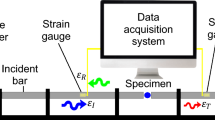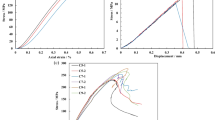Abstract
Displacement softening has shown to be an effective ingredient to overcome common deficiencies associated with DEM modeling based on bonded spherical particles (Ma and Huang in Int J Rock Mech Min Sci 104:9–19, 2018b). By incorporating a softening path in the normal force–displacement contact law, we show that the softening contact model can not only yield a realistic compressive over tensile strength ratio as high as about 30, but also capture the highly nonlinear failure envelope at the confined extension stress range, typical for quasi-brittle materials such as rocks and concretes. In our previous model, bond breakage at the particle scale is governed by the normal bond strength only. Here, we generalize the model by removing the restriction on the shear bond failure. Formulation of the displacement-softening model is first introduced. Novel features from modeling the behaviors of Berea sandstone without considering shear bond failure are summarized. How material behaviors at both the micro- and macroscale are affected by the inclusion of shear bond failure is then analyzed. Finally, implications of the numerical results in the context of how to calibrate material properties for DEM modeling in general is discussed.
















Similar content being viewed by others
Abbreviations
- \(\beta \) :
-
Reciprocal of the softening coefficient \(\chi \)
- \(\chi \) :
-
Softening coefficient
- \(\chi _{*}\) :
-
Critical value of \(\chi \)
- \(\eta _{\mathrm{{sc}}}\) :
-
Percentage of shear micro-cracks at 80\(\%\) of the post-peak loading level in the uniaxial compression test
- \(\eta _{\mathrm{{st}}}\) :
-
Percentage of shear micro-cracks at 80\(\%\) of the post-peak loading level in the direct tension test
- \(\eta _{\mathrm{{s}}}\) :
-
Percentage of shear micro-cracks at the peak stress level
- \(\kappa \) :
-
Normal over shear stiffness ratio of the point contact
- \(\mu \) :
-
Coulomb’s friction coefficient
- \(\omega \) :
-
ratio between the limiting confining stress where the tension cutoff ends and the uniaxial tensile strength
- \({\overline{\delta }}_{*}\) :
-
Normal bond stretch when the bond breaks (m)
- \({\overline{\delta }}_{\mathrm{{c}}}\), \({\overline{\delta }}_{2}\) :
-
Critical stretch (m)
- \({\overline{\delta }}_\mathrm{{n}}\) :
-
Normal bond stretch (m)
- \({\overline{\kappa }}\) :
-
Area contact (bond) stiffness ratio
- \({\overline{\sigma }}_{\mathrm{{c}}}\) :
-
Normal bond strength
- \({\overline{\tau }}_{\mathrm{{c}}}\) :
-
Shear bond strength
- \({\overline{\theta }}\) :
-
relative angle of rotation between the particles
- \({\overline{E}}_{\mathrm{{c}}}\) :
-
Area contact (bond) modulus (GPa)
- \({\overline{F}}_{n\text {max}}\) :
-
Maximum normal bond force (N)
- \({\overline{F}}_\mathrm{{n}}\) :
-
Normal bond force (N)
- \({\overline{F}}_{\mathrm{{s}}} \) :
-
Shear bond force (N)
- \({\overline{k}}_{\ell }\) :
-
Normal bond stiffness of the elastic loading path (N/m)
- \({\overline{k}}_\mathrm{{u}}\) :
-
Normal bond stiffness of the softening path (N/m)
- \({\overline{M}}^{n}\) :
-
Twisting moment (N m)
- \({\overline{R}}\) :
-
Bond radius (m)
- \({\overline{U}}_\mathrm{{b}}\) :
-
Nominal energy loss density associated with one bond breakage (MPa)
- \(\sigma _1\) :
-
Maximum principal stress (MPa)
- \(\sigma _3\) :
-
Minimum principal stress (MPa)
- \(\sigma _{\mathrm{{c}}}\), UCS:
-
Uniaxial compressive strength (MPa)
- \(\sigma _t\), UTS:
-
Uniaxial tensile strength (MPa)
- \(\varpi \) :
-
Shear over normal bond strength ratio
- A :
-
Cross-sectional area of the bond (\({\hbox {m}}^2\))
- D :
-
Diameter of the cylindrical assembly (mm)
- \(E_{\mathrm{{c}}}\) :
-
Point contact modulus (GPa)
- H :
-
Height of the cylindrical assembly (mm)
- J :
-
Polar moment of inertia (\({\text {m}}^4\))
- N :
-
Total number of micro-cracks at the peak stress
References
Bobich JK (2005) Experimental analysis of the extension to shear fracture transition in Berea sandstone. Master’s Thesis, Texas A&M University
Brace WF (1964) State of stress in the earth’s crust. In: Judd WR (ed) Brittle fracture of rocks. Elsevier, New York, pp 110–178
Cho N, Martin CD, Sego DC (2007) A clumped particle model for rock. Int J Rock Mech Min Sci 44(7):997–1010
Cundall PA, Strack ODL (1979) A discrete numerical model for granular assemblies. Geotechnique 29(1):47–65
Fairhurst C (1964) On the validity of the Brazilian test for brittle materials. Int J Rock Mech Min Sci Geomech Abstr 1(4):535–546
Fowell RJ (1993) The mechanics of rock cutting. In: Hudson JA (ed) Comprehensive rock engineering, vol 4. Pergamon Press Ltd., Oxford, pp 155–176
Haimson B (2007) Micromechanisms of borehole instability leading to breakouts in rocks. Int J Rock Mech Min Sci 44(2):157–173
Hampton J, Gutierrez M, Matzar L, Hu D, Frash L (2018) Acoustic emission characterization of microcracking in laboratory-scale hydraulic fracturing tests. J Rock Mech Geotech Eng 10(5):805–817
Hoek E, Bieniawski ZT (1965) Brittle fracture propagation in rock under compression. Int J Fract Mech 1(3):137–155
Hoek E, Martin CD (2014) Fracture initiation and propagation in intact rock—a review. J Rock Mech Geotech Eng 6(4):287–300
Huang H (1999) Discrete element modeling of tool-rock interaction. Ph.D. Thesis, University of Minnesota
Huang H, Detournay E (2008) Intrinsic length scales in tool-rock interaction. Int J Geomech 8(1):39–44
Huang H, Lecampion B, Detournay E (2013) Discrete element modeling of tool-rock interaction I: rock cutting. Int J Numer Anal Methods Geomech 37(13):1913–1929
Itasca Consulting Group, Inc (2015) PFC3D—particle flow code in 3-dimensions, Ver. 5.0. Minneapolis, MN
Ma Y, Huang H (2017) Tensile strength calibration in DEM modeling. In: 51st US rock mechanics/geomechanics symposium. American Rock Mechanics Association
Ma Y, Huang H (2018a) DEM analysis of failure mechanisms in the intact Brazilian test. Int J Rock Mech Min Sci 102:109–119
Ma Y, Huang H (2018b) A displacement-softening contact model for discrete element modeling of quasi-brittle materials. Int J Rock Mech Min Sci 104:9–19
Okubo S, Fukui K (1996) Complete stress–strain curves for various rock types in uniaxial tension. Int J Rock Mech Min Sci 33(6):549–556
Pierce M, Cundall P, Potyondy DO, Mas Ivars D (2007) A synthetic rock mass model for jointed rock. In: Proceedings of 1st Canada-US rock mechanics symposium, rock mechanics: meeting society’s challenges and demands, Vancouver, vol 1, pp 341–349
Potyondy DO (2012) A flat-jointed bonded-particle material for hard rock. In: Proceedings of 46th US rock mechanics/geomechanics symposium. American Rock Mechanics Association, Chicago, USA
Potyondy DO (2018) A flat-jointed bonded-particle material for rock. In: Proceedings of 52th US rock mechanics/geomechanics symposium. American Rock Mechanics Association, Seattle, WA
Potyondy DO, Cundall PA (2004) A bonded-particle model for rock. Int J Rock Mech Min Sci 41(8):1329–1364
Qu J, Cherkaoui M (2007) Fundamentals of micromechanics of solids. Wiley, New York
Ramsey J, Chester F (2004) Hybrid fracture and the transition from extension fracture to shear fracture. Nature 428(6978):63–66
Scholtès L, Donzé FV (2013) A DEM model for soft and hard rocks: role of grain interlocking on strength. J Mech Phys Solids 61:352–369
Stead D, Eberhardt E, Coggan JS (2006) Developments in the characterization of complex rock slope deformation and failure using numerical modelling techniques. Eng Geol 83(1–3):217–235
Tarokh A, Fakhimi A (2014) Discrete element simulation of the effect of particle size on the size of fracture process zone in quasi-brittle materials. Comput Geotech 62:51–60
Teufel LW, Clark JA (1981) Hydraulic-fracture propagation in layered rock: experimental studies of fracture containment. Technical report, Sandia National Labs., Albuquerque, NM (USA)
Wong TF, David C, Zhu W (1997) The transition from brittle faulting to cataclastic flow in porous sandstones: mechanical deformation. J Geophys Res Solid Earth 102(B2):3009–3025
Zietlow WK, Labuz JF (1998) Measurement of the intrinsic process zone in rock using acoustic emission. Int J Rock Mech Min Sci 35(3):291–299
Author information
Authors and Affiliations
Corresponding author
Additional information
Publisher's Note
Springer Nature remains neutral with regard to jurisdictional claims in published maps and institutional affiliations.
Rights and permissions
About this article
Cite this article
Ma, Y., Huang, H. Effect of shear bond failure on the strength ratio in DEM modeling of quasi-brittle materials. Acta Geotech. 16, 2629–2642 (2021). https://doi.org/10.1007/s11440-021-01220-x
Received:
Accepted:
Published:
Issue Date:
DOI: https://doi.org/10.1007/s11440-021-01220-x




